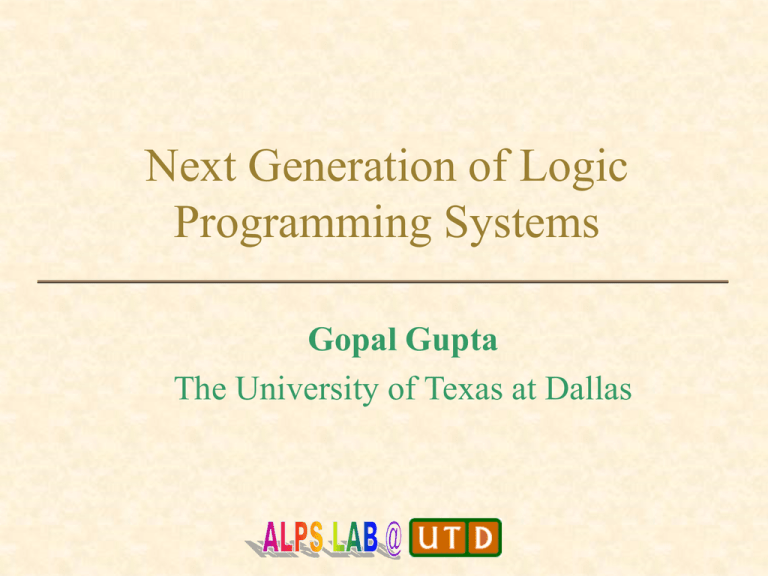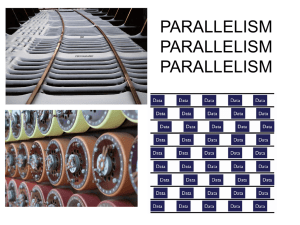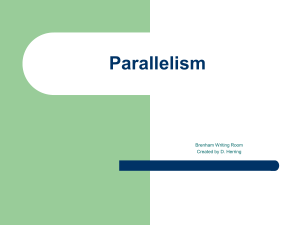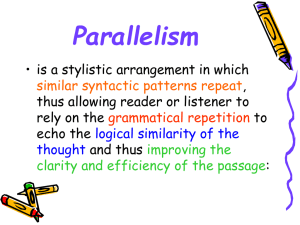Next Generation of Logic Programming Systems Gopal Gupta
advertisement

Next Generation of Logic Programming Systems Gopal Gupta The University of Texas at Dallas Acknowledgements • People: • Enrico Pontelli (New Mexico State Univ) • Hai-Feng Guo (University of Nebraska) & Karen Villaverde (NMSU) • Many others, discussions with whom have influenced our work: David H. D. Warren, Vitor Santos Costa, Manuel Hermenegildo, Khayri Ali, Peter Szeredi, Feliks Kluzinak, Mats Carlsson, Ines Dutra, Rong Yang, Tony Beuamont, Ines Dutra, Kish Shen, Raed Sindaha, … • Graduate students at UTD: A. Bansal, A. Mallya, L. Simon, Q. Wang • Funding Agencies: • National Science Foundation • Department of Energy (Sandia Labs) • NATO, Fullbright, JAIST (Japan), State of Texas Brief History of Parallel LP • Work on parallel LP began as soon as LP was invented: Pollard (Kowalski’s student) did first thesis in 1981. • Interest increased with the Japanese 5th Gen. Project: • Goal of the FGCS project: to build “fast, intelligent computers” • Speed to come from parallel processing • Intelligence via AI; realized through LP • Soon Parallel LP became synonymous with the FGCS project. The Global FGCS Project • FGCS spurred global interest in (parallel) LP (MCC, ECRC) • ECRC produced PEPSys (but, more importantly, produced Constraint Logic Programming). • MCC produced &-Prolog and spear-headed important work in deductive databases. • Many other groups got into parallel LP: • Bristol, Madrid, SICS, Argonne (Giga Lips project) • And important systems were produced: • Aurora, Muse, &-Prolog, Andorra-I, DDAS, EAM • Work continued in other groups in the 90s: • New Mexico State University • U. of Porto/UFRJ • Madrid (compile-time analysis) Global FGCS (cont’d) • Mistakes that the FGCS made: • Commitment to a h/w intensive approach (swept by RISC m/c) • Implementors dictated the language: • Concurrent Prolog to GHC to Flat GHC to KL1 • KL1 was too inexpressive & low-level a language for parallelism • By late 80s, software impl. of KL1 would beat its hardware impl. • Lessons to learn: • Do not change the language to ease implementation • Do not rely on custom hardware (Yes! Use the Intel multicore h/w ) • The Japanese were ahead of their times; we did not know then how to implement parallel search (or-parallelism) efficiently • Therefore, the FGCS project ignored or-parallelism. • We now know how to implement or-parallelism efficiently. Global FGCS Project’s Assumptions • Exploit parallelism implicitly & from full logic programming. • Stick to Prolog (Warren): By default, the user should see the same operational semantics as in a sequential implementation. • No slowdown guarantee (Hermenegildo): High sequential efficiency; parallel overhead should be a fixed factor (< 1). • Putting just one more processor should produce a speed-up. • We are interested in speed, not speed-ups • Implies: do not build your own sequential engine; extend existing ones • Simplicity of implementation (Gupta): The parallel impl. techniques should be simple; for two reasons: • Other people will incorporate them in their system • Impl. overhead will be low (easier to guarantee no slowdown) • No distrib. fat: One feature should not affect another’s perf. Brief Overview of Our Work • Goal: Exploit parallelism implicitly mainly from symbolic applications by programming them in (C)LP. • Symbolic Applications = Non-numerical applications = Reasoning/NLP/Databases/Compiling/Web/Decision support. • Applications of LP have been steadily increasing: Learning (ILP), Verification (Tabled LP), Planning (ASP). • Parallelism from numerical applications can also be exploited (number crunching in Fortran, control in LP) • Aim: to exploit parallelism from 2-20 processors; in the end we also succeeded in building scalable (or-) parallel systems. Types of Parallelism • Or-parallelism: multiple matching rules explored in parallel • IAP: goals that do not share bindings are executed in parallel (equiv. to evaluating args in parallel in FP) • DAP: goals that share bindings explored in parallel preserving dependencies (equivalent to executing a call and its argument in parallel). qsort([], []). qsort([P|T], L) :- partition(T, P, A, B), qsort(A, L1), qsort(B, L2), append(L1, [P|L2], L). Types of Parallelism (cont’d) • Data Or-parallelism: member(X, [1, .., n]) type of calls automatically flattened into a single choicepoint at run time under certain conditions • Last Alternative Optimization • Data And-parallelism: map(P, [1, …, n], R) automatically flattened into a single parcall frame at runtime under certain conditions • Last Parallel Call Optimization Parallel LP Systems • Large number of systems built: • Or-parallelism: Aurora (Bristol), Muse (SICS) • IAP: &-Prolog (MCC/Madrid), &-ACE (NMSU) • DAP: KL1 (ICOT), Parlog (Imperial), DDAS (Cambridge) • Challenge: combine all these forms of parallel systems into one • Attempted by the ACE system The ACE System • Exploits all sources of parallelism • Or-parallelism, independent and-parallelism, dependent andparallelism, data or-parallelism, data and-parallelism + coroutining • Engine highly optimized (based on SICStus Prolog with many optimizations for parallelism added) • Massive parallelism was not the aim; desktop multiprocessors (including multicores) • Shown good performance over a range of programs, many of which are thousands of line long. The ACE System • ACE organizes processors in teams (cf: Andorra-I) • IAP/DAP exploited within processors in a team • Or-parallelism exploited between teams • • • • Parallel overhead: approximately 5%; Supports full Prolog Ideal for network of distributed shared memory mult. Lessons learned from the ACE project: • Parallelism can be exploited from symbolic apps • And-parallelism harder to exploit in a scalable manner • Or-parallelism easier to exploit in a scalable manner The ACE System: Performance ACE Performance: Artwork ACE Performance: Artwork ACE Performance: ULTRA ACE Performance: ULTRA Scalable Or-parallelism • One reason why the Japanese FGCS project failed was the inability to implement or-parallelism efficiently (the first thing to be thrown out). • Today the multiple environment representation problem is understood well. • We know how to implement or-parallelism including on scalable parallel machines • Stack splitting: generalization of stack-copying in which alternatives are distributed at the time of stack copying. • Leads to superb performance on all types of parallel m/c. Stack-splitting Performance • Parallel overhead: 5-10%; 14 proc. Sun Sparc Stack-splitting on Beowulf Future LP Systems • LP is a vibrant field: more and more applications are being shown to be elegantly solvable by advanced LP systems: • • • • Tabled LP for Verification and Semantic Web apps Inductive LP for Machine Learning apps Constraint LP for Optimization/Search problems Answer Set Programming for Planning and reasoning problems • These advances have been made independent of each other. • Challenge for the LP community is to combine these advances into a single system in which parallelism is also exploited. • Such a system will allow highly complex applications to be developed with unprecedented ease. Need for Simple Impl. Techniques • Problem with declarative languages is that their impl. technology is very complex: main reason why multiple advances in LP have not been integrated into one. • Challenge for implementors: design techniques that are so simple that they can be incorporated in any LP system in a few man months of work. • Obviously, we have been working on these techniques: • • • • Stack splitting for realizing or-parallelism DRA for realizing tabled LP Co-recursion for realizing ASP Continuation trailing for realizing Andorra-I style coroutining Possible Applications • We are working on this next generation LP system that combines constraints, tabling, andorra-I, parallelism & ASP • Significantly complex applications become possible: • Model checking of specifications • Verification of timed systems (more general type of timed constraints become possible) • Complex planning/agent applications including those involving realtime become possible • Semantic web applications (e.g., implementations of description logics) can be easily implemented. • Bio-informatics applications w/ constraint LP • In all cases, exploitation of parallelism will result in performance that we think will be significantly better than that of dedicated systems. Declarative Languages • As we demonstrate the ease with which declarative languages can solve highly complex problems, declarative languages will eventually prevail. • Similar to debate between Roman numerals and decimal nos.; it took 100s of years for the world to accept decimal numbers. • IT industry is gradually moving towards declarative langs: • APIs: programming with functions • Automatic memory management (in Java, then in C#) • (more) logical pointers (i.e., less distinction between pointer & its value; pointer vs reference) • However, the most critical change needed (single assignment) not adopted yet; may take 50 years Conclusions • Parallelism can be exploited implicitly from logic programs. • Considerable work done in building parallel LP systems. • Considerable work done in making LP systems suitable for advanced (intelligent) applications (tabled LP, ILP, ASP, constraints). • The implementation techniques are reasonably well understood and various parallel systems built. • Considerable progress has been made in building support tools: automatic parallelizers, granularity analyzers, parallel execution visualization tools. • Future work: develop very simple implementation techniques that will help in combining various advanced LP systems along with parallelism to produce a super powerful, super fast LP system that will REALIZE THE FGCS DREAM 5th Gen Project: Reissue the Challenge 1. Advances in LP permit highly advanced (intelligent) apps: • • • • Tabled LP for Verification, Semantic Web ASP for planning, non-monotonic reasoning ILP for learning applications Constraint LP for search/optimization applications 2. Inexpensive multi-cores are becoming available, and the LP community knows how to efficiently exploit parallelism ITS TIME TO RESTART THE FIFTH GENERATON PROJECT WHICH WILL PUT 1 and 2 TOGETHER TO OBTAIN INTELLIGENCE AND SPEED References • • • • • G. Gupta, E. Pontelli, K. Ali, M. Carlsson, M. Hermenegildo. Parallel Execution of Prolog Programs: A Survey. ACM Transactions on Programming Languages and Systems, Vol 23, No. 4, pp. 472-602. G. Gupta. Next Generation Logic Programming Systems. Technical Report, UT Dallas. 2003. E. Pontelli. High Performance Logic Programmng. Ph. D. Thesis, NMSU, 1997. H-F Guo. High Performance Parallel Prolog Systems. Ph.D. Thesis, NMSU, 2000. K. Villaverde. Scalable Parallel Prolog on the Beowulf. Ph.D. thesis. NMSU, 2003.




